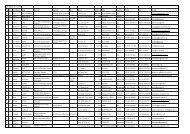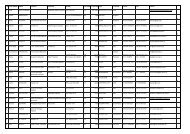icvg 2009 part I pp 1-131.pdf - Cornell University
icvg 2009 part I pp 1-131.pdf - Cornell University
icvg 2009 part I pp 1-131.pdf - Cornell University
You also want an ePaper? Increase the reach of your titles
YUMPU automatically turns print PDFs into web optimized ePapers that Google loves.
— 47 —<br />
result suggests that the ampeloviruses adhere loosely to the<br />
seed surface, while GRSpaV and GVA may be either<br />
firmly attached or internal.<br />
To test whether GRSPaV was internal, seeds from<br />
each variety listed in Table 1 were treated with bleach and<br />
cut into two sections. Embryonic (es) and non-embryonic<br />
(ne) halves of the seed were tested separately. Both<br />
sections as well as the intact seed (cs) contained the<br />
GRSPaV RNA as revealed by RT-PCR (Fig. 1).<br />
Table 1. Virus status of the varieties which were the source of the<br />
seeds used in this study<br />
Var./ Virus GRSPaV GVA GLRaV-1 GLRaV-9<br />
Cab Sauv.<br />
SA 125 yes yes no yes<br />
Grenache yes yes yes no<br />
Dolcetto yes yes yes no<br />
Figure 1. RT-PCR detection of GRSPaV in seeds of Cabernet<br />
Sauvignon (lanes 1-3), Grenache (lanes 4-6) and Dolceltto (lanes<br />
7-9) following a bleach treatment. M, DNA ladder, pUC 19 Hpa<br />
II cut. Lane 10, positive control. cs, complete seed; es, embryo<br />
section; ne, non-embryo section.<br />
M 1 2 3 4 5 6 7 8 9 10<br />
These results indicate that GRSPaV and GVA are<br />
internal but fail to distinguish between the possibilities that<br />
they are retained in the endosperm or vascular system of<br />
the seed only, or are localized in the embryo. The<br />
resolution of this question will depend on germinating and<br />
testing emerged seedlings for these viruses, as presence of<br />
virus in the seedling will confirm that it has entered the<br />
embryo from the vascular system of the seed (Wang &<br />
Maule, 1994).<br />
If viruses are shown to be seedborne, then progeny<br />
from infected parents could be infected. Hence breeders<br />
material is not necessarily free of embryo or pollen borne<br />
viruses. RT-PCR is shown here to be sensitive enough to<br />
detect virus in seed and to ensure that breeders release<br />
virus-tested lines to the industry. The high incidence of<br />
GRSPaV in Australian grapevines is being addressed by<br />
our 12 year old program of shoot tip culture and<br />
thermotherapy (R. Davies, unpublished). The most<br />
recalcitrant elongated virus for elimination is GRSPaV<br />
followed by GVA, while Ampeloviruses (leafroll viruses)<br />
are easily eliminated. GRSPaV requires an elevated<br />
temperature to be eliminated from grapevine tissue. We<br />
have noticed that once this virus is removed, the plantlet<br />
would a<strong>pp</strong>ear to be free of all other viruses. Under such a<br />
harsh regime, it is only necessary to test for this virus as all<br />
other viruses have been eliminated.<br />
350 bp<br />
cs es ne cs es ne cs es ne +<br />
Table 2. Viruses detected in seeds of Cabernet and Grenache after soaking in water or bleach<br />
Virus: RSPaV 1 GVA 1 GLRaV-1 2 GLRaV-9 1<br />
Expt. No. water bleach water bleach water bleach water bleach<br />
1 yes yes yes yes yes yes no no<br />
2 yes yes yes yes yes no yes no<br />
3 yes yes yes yes yes yes yes yes<br />
4 yes yes yes no no no yes no<br />
1 detected in Cabernet, 2 detected in Grenache<br />
LITERATURE<br />
HABILI, N. & RANDLES, J. 2002. Developing a standardised<br />
sampling protocol for consistent detection of grapevine viruses by<br />
the PCR assay. The Australian & New Zealand Grapegrower and<br />
Winemaker 464, 88-92.<br />
HABILI, N. & RANDLES, J. 2004. Descriptors for Grapevine Virus A-<br />
associated syndrome in Shiraz, Merlot and Ruby Cabernet in<br />
Australia, and its similarity to Shiraz Disease in South Africa. The<br />
Australian and New Zealand Grapegrower and Winemaker 488,<br />
71-74.<br />
MACKENZIE, D., McLEAN, M., MUKERJI, S. & GREEN, M.<br />
1997. Improved RNA extraction from woody plants for the<br />
detection of viral pathogens by reverse-transcription-polymerase<br />
chanin reaction. Plant Disease 81, 222-226.<br />
ROWHANI, A., ZHANG, Y., CHIN, J., MINAFRA, A., GOLINO, D.<br />
& UYEMOTO, J. 2000. Grapevine Rupestris stem pitting<br />
associated virus: population diversity, titer in the host, and possible<br />
transmission vector. Extended Abstracts 13th Meeting of ICVG,<br />
Adelaide, Australia, 37.<br />
SYMONS, R., HABILI, N. & BONFIGLIOLI, R. 2000. Waite<br />
Diagnostics – Development of a diagnostic service for the<br />
Australian viticultural industry. Extended Abstracts 13th Meeting of<br />
ICVG, Adelaide, Australia, 149.<br />
STEWART, S. & NASSUTH, A. 2001. RT-PCR based detection of<br />
Rupestris stem pitting associated virus within field-grown<br />
grapevines throughout the year. Plant Disease 85, 617-620.<br />
WANG, D.J. & MAULE, A. 1994. A model for seed transmission of a<br />
plant virus: genetic and structural analyses of pea embryo invasion<br />
by pea seed-borne mosaic virus. The Plant Cell 6, 777-787.<br />
ZHANG, Y., UYEMOTO, J., GOLINO, D. & ROWHANI, A. 1998.<br />
Nucleotide sequence and RT-PCR detection of a virus associated<br />
with grapevine rupestris stem pitting disease. Phytophathology 88,<br />
1231-1237.<br />
ACKNOWLEDGEMENTS<br />
We would like to thank Mr. Tony Herve, the Director of Clean<br />
Plant Technology, South Australia, for su<strong>pp</strong>ort and advice.<br />
Progrès Agricole et Viticole, <strong>2009</strong>, Hors Série – Extended abstracts 16 th Meeting of ICVG, Dijon, France, 31 Aug – 4 Sept <strong>2009</strong>




